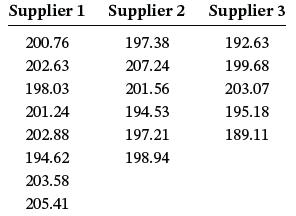In 1895, Ignaz Schwinn and his partner, Adolph Arnold, incorporated Arnold, Schwinn & Company to produce bicycles.
Question:
In 1895, Ignaz Schwinn and his partner, Adolph Arnold, incorporated Arnold, Schwinn & Company to produce bicycles. In the early years, with bicycle products such as the “Roadster,” a single-speed bike that weighed 19 pounds (about 9 kg), Schwinn products appealed to people of all ages as a means of transportation. Because of the advent of the automobile in 1909, the use of bicycles as a means of transportation waned. In that same year, Schwinn developed manufacturing advances that allowed bicycles to be made more cheaply and sturdily. These advances opened a new market to the company as it manufactured and sold bicycles for children for the first time. Meanwhile, Ignaz Schwinn bought out Arnold to become the sole owner of the company. Over the next 20 years, Schwinn bought out two motorcycle companies and developed mudguards as its major technological achievement. In the 1930s, Schwinn developed a series of quality, appearance, and technological breakthroughs including the balloon tire, which some say was the biggest innovation in mountain bike technology; the forewheel brake; the cantilever frame; and the spring fork. In 1946, built-in kickstands were added to its bikes. In the 1950s, Schwinn began an authorized dealer network and expanded its parts and accessory programs. In the 1960s, Schwinn expanded into the fitness arena with in home workout machines. In 1967, the company became the Schwinn Bicycle Company. The company introduced the Airdyne stationary bike in the late 1970s. In 1993, the company filed for bankruptcy, and in 1994 it was moved to Boulder, Colorado, to be nearer the mountain bike scene. In the next several years, Schwinn’s mountain bike products won accolades and awards. In 2001, Pacific Cycle, the U.S.’s largest importer of quality bicycles, purchased Schwinn and united Schwinn bicycle lines with Pacific Cycle’s other brands. Under new management in 2002, Schwinn bicycles began being featured, along with Pacific Cycle’s other bikes, at mass retail outlets in North America. In 2004, Dorel Industries, Inc., a global consumer products company based in Montreal, purchased Pacific Cycle and made it a division of Dorel. Schwinn bicycles, now a part of the Dorel empire, are still made with quality for dependability and performance, and they continue to lead the industry in innovation.
Discussion1. What is the age of the target market for Schwinn bikes? One theory is that in locales where mountain bikes are more popular, the mean age of customers is older than in locales where relatively little mountain biking is done. In an attempt to test this theory, a random sample of Colorado Springs customers is taken along with a random sample of customers in Alberta and British Columbia. The ages for these customers are given here. The customer is defined as “the person for whom the bike is primarily purchased.” The shape of the population distribution of bicycle customer ages is unknown. Analyze the data and discuss the implications for Schwinn manufacturing and sales. 2. Suppose for a particular model of bike, the specified mass of a handlebar is 200 g and Schwinn uses three different suppliers of handlebars. Suppose Schwinn conducts a quality control study in which handlebars are randomly selected from each supplier and weighed. The results (in grams) are shown next. It is uncertain whether handlebar mass is normally distributed in the population. Analyze the data and discuss what the business implications are to Schwinn.
2. Suppose for a particular model of bike, the specified mass of a handlebar is 200 g and Schwinn uses three different suppliers of handlebars. Suppose Schwinn conducts a quality control study in which handlebars are randomly selected from each supplier and weighed. The results (in grams) are shown next. It is uncertain whether handlebar mass is normally distributed in the population. Analyze the data and discuss what the business implications are to Schwinn. 3. Quality technicians at Schwinn’s manufacturing plant examine the finished products for paint flaws. Paint inspections are done on a production run of 75 bicycles. The inspection data are coded and the data analyzed using Minitab. If a bicycle’s paint job contained no flaws, a 0 is recorded, and if it contained at least one flaw, the code used is a 1. Inspectors want to determine whether the flawed bikes occur in a random fashion or in a nonrandom pattern. Study the Minitab output. Determine whether the flaws occur randomly. Report on the proportion of flawed bikes and discuss the implications of these results to Schwinn’s production management.
3. Quality technicians at Schwinn’s manufacturing plant examine the finished products for paint flaws. Paint inspections are done on a production run of 75 bicycles. The inspection data are coded and the data analyzed using Minitab. If a bicycle’s paint job contained no flaws, a 0 is recorded, and if it contained at least one flaw, the code used is a 1. Inspectors want to determine whether the flawed bikes occur in a random fashion or in a nonrandom pattern. Study the Minitab output. Determine whether the flaws occur randomly. Report on the proportion of flawed bikes and discuss the implications of these results to Schwinn’s production management. Employing the American Hospital Association database, answer the following:1. Use a Mann-Whitney U test to determine if there is a significant difference between children’s hospitals and psychiatric hospitals (Service variables) on Personnel.2. Use a Mann-Whitney U test to determine if there is a significant difference between children’s hospitals and long-term acute care hospitals (Service variables) on Personnel.3. Use a Mann-Whitney U test to determine if there is a significant difference between psychiatric hospitals and long-term acute care hospitals (Service variables) on Personnel.
Employing the American Hospital Association database, answer the following:1. Use a Mann-Whitney U test to determine if there is a significant difference between children’s hospitals and psychiatric hospitals (Service variables) on Personnel.2. Use a Mann-Whitney U test to determine if there is a significant difference between children’s hospitals and long-term acute care hospitals (Service variables) on Personnel.3. Use a Mann-Whitney U test to determine if there is a significant difference between psychiatric hospitals and long-term acute care hospitals (Service variables) on Personnel.
Step by Step Answer:

Business Statistics For Contemporary Decision Making
ISBN: 9781119577621
3rd Canadian Edition
Authors: Ken Black, Ignacio Castillo





